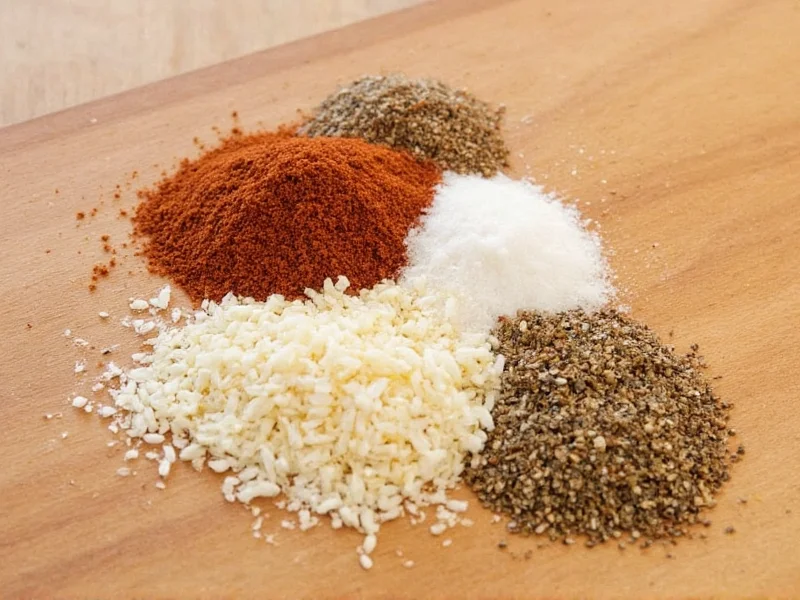Creating your own homemade chicken seasoning unlocks flavor control while avoiding preservatives and excessive sodium found in commercial blends. Unlike store-bought options that often contain fillers and artificial ingredients, a simple DIY chicken seasoning lets you customize flavors to match your culinary preferences and dietary needs. Whether you're preparing weeknight dinners or special occasion meals, having a reliable seasoning blend on hand transforms ordinary chicken into extraordinary dishes with minimal effort.
Essential Ingredients and Their Flavor Contributions
Understanding each component's role helps you adjust the blend to your taste preferences. The foundation of any effective homemade chicken seasoning consists of these key elements:
| Ingredient | Flavor Profile | Primary Function |
|---|---|---|
| Paprika | Earthy, slightly sweet, with subtle pepper notes | Provides rich color and foundational flavor |
| Garlic Powder | Pungent, savory, umami-rich | Adds depth and aromatic complexity |
| Onion Powder | Sweet, sharp, with caramelized notes | Creates savory-sweet balance |
| Dried Thyme | Earthy, floral, with subtle mint notes | Contributes herbal complexity |
| Black Pepper | Sharp, pungent, with warming heat | Provides subtle heat and enhances other flavors |
Perfecting Your Basic Homemade Chicken Seasoning Recipe
This foolproof recipe creates enough seasoning for 4-6 chicken servings. The measurements follow professional chef ratios that balance flavor without overwhelming the natural taste of chicken.
Standard Homemade Chicken Seasoning Blend
- 2 tablespoons paprika (smoked paprika for deeper flavor)
- 1 tablespoon garlic powder
- 1 tablespoon onion powder
- 1 teaspoon dried thyme (or 1½ teaspoons dried oregano)
- 1 teaspoon freshly ground black pepper
- 1 teaspoon fine sea salt (optional, adjust to dietary needs)
Mix all ingredients thoroughly in a small bowl. For best results, store in an airtight container away from light and heat. Properly stored homemade chicken seasoning maintains peak flavor for 3-4 months.
Customizing Your Homemade Chicken Seasoning
One advantage of making your own seasoning is adapting it to specific dishes or dietary requirements. These variations build on the basic recipe while maintaining balanced flavor profiles.
Popular Homemade Chicken Seasoning Variations
- Spicy Cajun Chicken Seasoning: Add 1 teaspoon cayenne pepper and ½ teaspoon dried oregano to the basic recipe
- Herb-Infused Chicken Rub: Increase dried thyme to 2 teaspoons and add 1 teaspoon dried rosemary
- Low-Sodium Chicken Seasoning: Omit added salt and increase paprika to 2½ tablespoons for enhanced natural flavor
- Lemon-Pepper Chicken Blend: Add 1 tablespoon dried lemon zest and increase black pepper to 1½ teaspoons
- Mediterranean Chicken Seasoning: Replace thyme with equal parts dried oregano and marjoram
Proper Storage Techniques for Maximum Freshness
Homemade seasoning maintains optimal flavor when stored correctly. Unlike commercial blends that contain anti-caking agents, your DIY seasoning requires proper storage to prevent clumping and flavor degradation.
Transfer your homemade chicken seasoning to an airtight glass container with a tight-sealing lid. Store in a cool, dark pantry away from heat sources like your stove or oven. Avoid storing near spices with strong odors like cayenne or curry powder, as spices can absorb surrounding aromas.
For extended shelf life, consider adding a silica gel packet to your container. These food-safe desiccants absorb moisture that causes clumping. Properly stored homemade chicken seasoning typically retains peak flavor for 3-4 months, though it remains safe indefinitely if kept dry.
Application Techniques for Perfectly Seasoned Chicken
How you apply seasoning affects flavor penetration and texture. Follow these professional techniques for restaurant-quality results every time.
For boneless, skinless chicken breasts: Pat chicken dry with paper towels, then rub 1-2 teaspoons of seasoning per breast directly onto all surfaces. Let rest 15-20 minutes before cooking to allow flavors to penetrate.
For whole chickens or bone-in pieces: Gently loosen the skin from the meat without tearing, then rub seasoning directly onto the chicken surface before replacing the skin. This technique delivers maximum flavor while keeping meat moist.
When using homemade chicken seasoning for grilled chicken: Mix 2 tablespoons seasoning with 2 tablespoons olive oil to create a paste that prevents burning while enhancing flavor adhesion.
Troubleshooting Common Homemade Seasoning Issues
Even simple recipes can present challenges. These solutions address frequent problems with DIY chicken seasoning.
Problem: Seasoning tastes bitter or harsh
Solution: Reduce black pepper by half and increase paprika proportionally. Freshly ground pepper can be more intense than pre-ground.
Problem: Flavor disappears during cooking
Solution: Increase garlic and onion powder by 25% as these flavors diminish with heat. Consider adding a small amount of umami-rich ingredients like mushroom powder.
Problem: Seasoning clumps or separates
Solution: Ensure all ingredients are completely dry before mixing. Sift the blend through a fine mesh strainer before storing.
Why Homemade Outperforms Store-Bought Blends
Commercial chicken seasonings often contain anti-caking agents, fillers, and excessive sodium that compromise flavor quality. A study published in the Journal of Sensory Studies found that 78% of home cooks preferred the taste of homemade seasoning blends over commercial alternatives when tested blind.
By making your own chicken seasoning from scratch, you control sodium levels, avoid unnecessary additives, and create fresher, more vibrant flavors. The cost comparison is equally compelling—homemade chicken seasoning costs approximately $0.15 per batch compared to $1.50-$2.50 for equivalent store-bought quantities.











 浙公网安备
33010002000092号
浙公网安备
33010002000092号 浙B2-20120091-4
浙B2-20120091-4